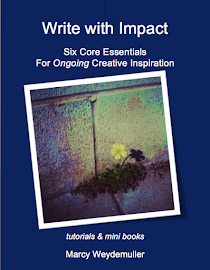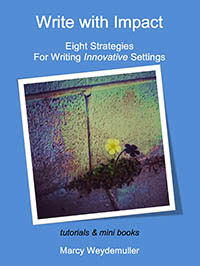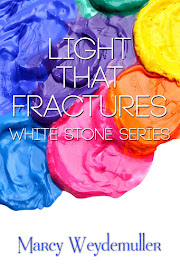Tuesday, October 30, 2018
New Five Star Review!
So excited to receive such an in depth review from author Karen Weisner on my new workbook release.
If you'd like to read it too click the cover on the right hand side. :)
Labels:
Amazon Book Review,
Karen S. Wiesner,
Twelve Basic Concepts to Influence Your Story,
Write with Impact
Thursday, October 25, 2018
Journal With Impact: Memoir Seeds
Workshop:
Six Conversations for Writing Creative
Journals
“Writers are
the custodians of memories.” William Zinsser
In
his book Writing About Your Life Zinsser
continues, “Your biggest stories will often have less to do with their subject
than with their significance…how that situation affected you.”
Sometimes
it will be an anecdote shared over a meal with family and friends or a mutual
special occasion over many years. Or a life changing experience that you are
still exploring the depths of and know others can benefit from your discovery.
Once we identify the significance then we will have a better understanding
whether it is meant for personal or public communication. The reflection
exercises we’ve looked at so far keep us in touch with ourselves now; the
memoir exercises enable us to see how our past and present intertwine.
Seeds as
Prompts
Begin
building a memory journal for yourself. Tie it to specific personal
memories—both trauma and joy—and fix the location whenever relevant. Focus the
emotional description. Next to each category list the senses incorporated and
how the senses responded.
Or,
if it feels too emotional to address with a clear perspective, take a step back
and examine the memory as if you are a main characters that you are questioning
in an interview.
Begin
with basic journal entries as before:
· saddest day
· happiest day
· scariest
· challenging
· hopeful
· joyous
· disappointing
· despairing
· successful
Action
Steps:
1. Choose two categories to focus on. Focus
on one that you have a lot of material for, and one that feels limited so far.
2. Make a list of questions for what is
missing from your memory for each category?
Share: What
surprised you?
Read deep, marcy
Labels:
Free blog workshop,
Journal with Impact,
Memoir,
Six Conversations,
Writing Creative Journals
Thursday, October 18, 2018
Journal With Impact: Memoir
Workshop:
Six Conversations for Writing Creative
Journals
“How did I
come to believe that what I knew was also what mattered? And, more to the point
for the future, is it what matters?” Patricia Hampl
In
her book, I Could tell You Stories,
Hampl explores the realm of memory in auto-biographical writing connected by
the impulse to remember. She pointed out that both Kafka and Rilke saw memory, “not experience”, as holding the
sovereign position in imagination.
For
herself Hampl discovered: “The
recognition of one’s genuine material seems to involve a fall from the phony
grace of good intentions and elevated expectations.” If we are unable to
infuse our memories, or perhaps our search for our memories into our work then
we rob it of honest quest and discovery and an imagination that connects. Each
person’s voice is unique and bears witness to life. But in order to share, we
first need to identify what really matters to us.
“We store in
memory only images of value.”
Action
Steps:
1. Choose a first memory of an experience
you’ve had twice and write each up as an autobiographical event. For example,
the very first day you went to school and then the very first day you went to
school in high school, or college, or several years later for graduate work.
2. Or perhaps choose an area in which you
became accomplished. The first day you swam in a pool and then first time you
swam in a race.
Share:
What emotions rose to the surface? Were there similar ones in both choices?
NOTE:
Memoir writing is extremely personal even when you are not preparing to share
it publicly. Whether you have mountains of material already at hand and are
trying to sort it out, or tumbling about in your heart and soul with no clear
direction, it takes time and energy to understand, shape, and mold. Sometimes a
seemingly simple exercise will knock you over emotionally for no apparent
reason.
So
over these next few weeks be kind to yourselves and take a break whenever you
need to. The purpose of a memoir journal is to assist you in uncovering and
engaging heart, soul, and mind, stories that you want to connect with.
Read deep, marcy
Labels:
Free blog workshop,
Journal with Impact,
Memoir,
Six Conversations,
Writing Creative Journals
Thursday, October 11, 2018
Journal With Impact: Nature Inform
Workshop:
Six Conversations for Writing Creative
Journals
“Hunting,
fishing, drawing, and music occupied my every moment. Cares I knew not, and
cared naught about them.” John James Audubon
We
began this journal section saying, “Art, music, and imagery can become a
separate language of communication. So too does nature. It is a language that
speaks to us, by personally touching our hearts and souls with meaning, and
also by allowing us to share across time and culture with others. Nature as
reflection builds a bridge of communication that gives us soul-to-soul threads
of understanding.”
With
whom do you want to share your discoveries? What age? What method: art,
writing, music, comic books, maps, photos, or…? What will be your bridge?
Sharing builds communication. It’s like the excitement of watching a gift being
opened for a special reason.
We
may not have every moment to pour ourselves in, as did Audubon, but because of
his commitment he still continues to inspire others because of his nature
discoveries that have been passed down through information and art.
And
the bonus is the memories continue to be fresh with each encounter. Nature is
ever present and ever changing. Share both the ordinary and the unexpected.
Action
Steps:
1. Ask yourself, ‘What are three parts of
nature that I find the most interesting, intriguing, confusing, symbolic?’
Other categories? Make your own lists.
2. Then ask yourself, ‘What could they be
springboards to?’ If as a writer perhaps a new setting for a scene or novel, a
vocabulary for metaphors, a source of study, or perhaps a preparation for essays,
or articles or devotions.
3. Or a hands-on project for yourself or your
neighbors or city? What might that look like? With whom might you be able to
share insights to fuel creativity and action?
4. Start a reading list to dig deeper into
your territory.
Share: What is your
dream? What is your first step?
Read deep, marcy
Labels:
Free blog workshop,
Inform,
Journal with Impact,
Nature,
Six Conversations,
Writing Creative Journals
Tuesday, October 9, 2018
Journal With Impact: Nature Interact
“A
true conservationist is a man who knows that the world is not given by his
fathers, but borrowed from his children.” John James Audubon
John
James Audubon was both a scientist and an artist. He dove into his passion and
has left an amazing legacy not only of his own work, but the inspiration he
passed on to others. What action from your journal last week has built up your
desire to combine your own practical and creative abilities into an ongoing
interaction?
Or,
where would you like to investigate more? What time can you carve out? Has
anything surprised you in your journal so far that is changing your
perspective? The possibilities are endless in nature so to interact means to
listen to your heartbeat for your passion.
Several
years ago Geary Mandrapilias shared her story in Nature’s Garden that she had
begun gardening as an outdoor activity while her children played in the yard.
“I was definitely collecting plants but…I certainly did not know I was making a
habitat.” Her passion grew and when a fellow Master Gardener suggested she
become a wildlife rehabilitator, another one of her interests blended in. She
built a chain of three small ponds into her yard that became a habitat for
turtles. Later an “assortment of birds, rabbits, squirrels, lizards, and other
wildlife” also came. (Nature’s
Garden Magazine Summer 2007)
Sometimes
taking our first step of interaction can begin a surprising journey.
In
a recent visit to Milwaukie, Oregon, I spotted a few Wildlife signs near
driveways during a walk. When I took a closer look I saw they were
certifications for backyard habitats. The Portland Audubon society has a
program to assist homeowners to interact and help preserve local habitats.
Their five program elements include: “removal of aggressive weeds, naturescaping with native
plants, pesticides reduction, stormwater management and wildlife stewardship.
Two of their concerns under wildlife stewardship include providing water and
shelter, and decreasing hazards to wildlife.
Journal ideas of how you would like to interact with nature.
Then write out other interests and daydream how they might merge—either in
concrete physical action and/or art.
Action
Steps:
1. Look up the
Audubon websites and resources in your own geographic home and see what
stewardship or habitat possibilities you might be able to incorporate, even if
in a crowded city.
2. What actions
will best combine your personal factual science and your art lean together?
3. Plan your
project.
Share: What is one
simple action you discovered for your location?
Read deep, marcy
Labels:
Free blog workshop,
Interact,
Journal with Impact,
Nature,
Six Conversations,
Writing Creative Journals
Thursday, October 4, 2018
Journal With Impact: Nature Interest
Workshop: Six
Conversations for Writing Creative
Journals
“The
act of recording a life, in healthy solitude and active connection to loved
terrain, is also the act of creating a life.” Hannah
Hinchman
How
to find that creative interest? Begin from your own home habitat.
Like
any other journal, the nature journal also extends from the five minute quick
write such as ‘what did I see in nature today that affected me’ to a deep
detailed scientific analysis. Sometimes the more we connect the more we want to
explore. Our interest is not satisfied with a passing glance.
However
there are also so many possibilities to explore that we’re not always sure
exactly where we’d like to dig deep. Here are some suggestions to try out a day
at a time, or a week at a time, or for long-term studies a month. When you find
your journal responses producing more and more questions and ideas, then follow
that curiosity.
1.
Take a different route for a walk each time. Look for anything that surprises
you.
2.
Or look for a specific feature: type of tree, animals you see, smells and
shapes.
3.
Keep a log of the weather patterns or the sunrise, sunset for a month.
4.
Choose one spot and look at it morning noon and night. What stays the same?
What is different?
5.
Choose a particular study such as the moon, or tides, or seasons and watch the
changes over a long period of time.
6.
Or, on the same idea, watch a nest of birds for their entire cycle while taking
daily readings. Mark the day-by-day different changes.
7.
If you are keeping a more scientific study create a template page where you can
mark dates or time of day, notes pertinent to your study and sketches or
photos.
8.
Keep a sketch journal only. Or, if unable to draw, take photographs and make it
a visual journal.
9.
Collect leaves or seeds or stones if allowed. Draw or trace them.
Once,
when I first moved to a city that had a different skyline than any I had ever seen
I spent every Sunday evening over the next two months describing the colors in
the sky. Not one was a replica.
The
main idea is to enjoy the beauty and mystery and astounding creation that too
often we can take for granted in our busy lives.
Action
Steps:
1. Which of the above caught your interest or
led you to your own version? Why?
2. Design a study plan that fits your life so
you look forward to each week’s discovery.
Share: What would
you like to watch for in nature over the next week or month?
Read deep, marcy
Labels:
Free blog workshop,
Interest,
Journal with Impact,
Nature,
Six Conversations,
Writing Creative Journals
Tuesday, October 2, 2018
Journal With Impact: Nature Identify
Workshop:
Six Conversations for Writing Creative
Journals
“Journaling
from the events of daily life does not mean simply keeping a log or diary of
who we saw and what we did each day. It means, rather, writing down the
experiences that have affected our soul in a particular way.” Anne
Broyles
Identify what inspires you through nature.
Here is one
view—one day—one experience—that had the ability to capture a whole inspiration
as Rainer Maria Rilke offers up a prayer from the land that carries across the
centuries of time.
Autumn
“The leaves are falling, falling as if from
far off,
as
if in the distance heavens gardens withered;
they fall
with gestures that say, ‘no.’
And in the
nights the heavy earth falls
from all the
stars into aloneness.
We are all
falling. This hand is falling.
And look at
the others: it is in them all.
And yet
there is One who holds this falling
with
infinite softness in his hands.”
Just
as a reflective journal helps connect you to your daily life from a variety of
views, so too can a nature journal be approached either randomly, or while
trying to study a particular concept, and then go deeper into certain aspects.
One
creative writing exercise, often known as the index or table of contents, works
well with nature journals to grasp an initial overview to start from. The idea
is to make a list of about 20 to 30 ideas or subjects of your choice. A list of
potential titles works well too. Do it quickly under a timer to help keep your
critical thinking set aside. Try five or ten minutes. One time after I put
together a mock index of things I’d like to read/write/study I discovered to my
great surprise that 22 out of 25 topics were all nature related.
Below are some headings Hannah
Hinchman used in A Trail Through Leaves.
“Feeling It In Your Bones
The Power of
the Ordinary
The Flow Of
Attention
Seeing Order
Seeing Chaos
Unmeasureable
Phenomena”
Action
Steps:
1. Make a table of contents list from one
particular season and write down as many nature memories you can think of. It
can be in a specific season one year or a general overview of memories over the
years.
2. Then expand each one with concrete
details. For example: Did it rain one whole week? What did it sound like—list
all the other characteristics you remember as well.
3. Now go back to the description exercise
and choose five episodes from your list above that affected you either
positively or negatively. Now write them up in descriptive detail.
Share: Which season
most captured your heart?
Read deep, marcy
Labels:
"Autumn" Potential Titles,
Free blog workshop,
Identify,
Journal with Impact,
Nature,
Six Conversations,
Writing Creative Journals
Subscribe to:
Posts (Atom)









